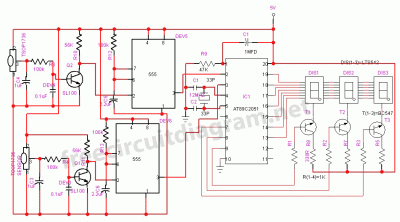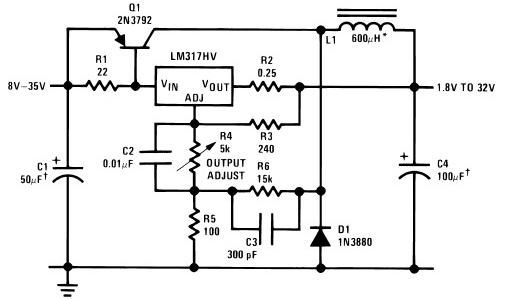
Telephone Call Recording Circuit Circuit

The DC voltage on a telephone line typically ranges from 45 to 50 V when on-hook and drops to around 6 V when off-hook. This circuit utilizes the voltage drop to activate a relay, which in turn controls a cassette tape recorder. Audio is extracted through a network and fed into the microphone input of the cassette.
The described circuit operates by leveraging the characteristics of the telephone line's DC voltage. When the telephone is in the on-hook state, the voltage remains high, typically between 45 and 50 volts. In this condition, the relay remains deactivated, preventing any current flow to the cassette tape recorder. However, when the telephone goes off-hook, the voltage significantly drops to approximately 6 volts. This voltage drop is the critical factor that triggers the relay to activate.
The relay serves as an intermediary switch that allows the low-voltage signal to control the operation of the cassette tape recorder. Upon activation, the relay closes its contacts, allowing power to flow to the cassette tape recorder, thus enabling it to start recording or playback audio as required.
Additionally, the circuit incorporates an audio extraction network designed to capture the audio signals from the telephone line. This network typically consists of passive components such as resistors and capacitors, which filter and condition the audio signal before routing it to the microphone input of the cassette tape recorder. The audio quality and clarity are maintained through careful selection of these components, ensuring that the recorded audio accurately represents the original sound captured from the telephone line.
Overall, this circuit effectively combines telecommunication and audio recording technologies, providing a practical solution for capturing audio directly from telephone conversations. The dc voltage present on a telephone line is usually around 45 to 50 V on-hook and 6 V off-hook. This circuit uses This drop in voltage to activate a relay. The relay controls a cassette tapeTecorder. Audio is taken off through a network to the microphone input of the cassette.
The described circuit operates by leveraging the characteristics of the telephone line's DC voltage. When the telephone is in the on-hook state, the voltage remains high, typically between 45 and 50 volts. In this condition, the relay remains deactivated, preventing any current flow to the cassette tape recorder. However, when the telephone goes off-hook, the voltage significantly drops to approximately 6 volts. This voltage drop is the critical factor that triggers the relay to activate.
The relay serves as an intermediary switch that allows the low-voltage signal to control the operation of the cassette tape recorder. Upon activation, the relay closes its contacts, allowing power to flow to the cassette tape recorder, thus enabling it to start recording or playback audio as required.
Additionally, the circuit incorporates an audio extraction network designed to capture the audio signals from the telephone line. This network typically consists of passive components such as resistors and capacitors, which filter and condition the audio signal before routing it to the microphone input of the cassette tape recorder. The audio quality and clarity are maintained through careful selection of these components, ensuring that the recorded audio accurately represents the original sound captured from the telephone line.
Overall, this circuit effectively combines telecommunication and audio recording technologies, providing a practical solution for capturing audio directly from telephone conversations. The dc voltage present on a telephone line is usually around 45 to 50 V on-hook and 6 V off-hook. This circuit uses This drop in voltage to activate a relay. The relay controls a cassette tapeTecorder. Audio is taken off through a network to the microphone input of the cassette.





